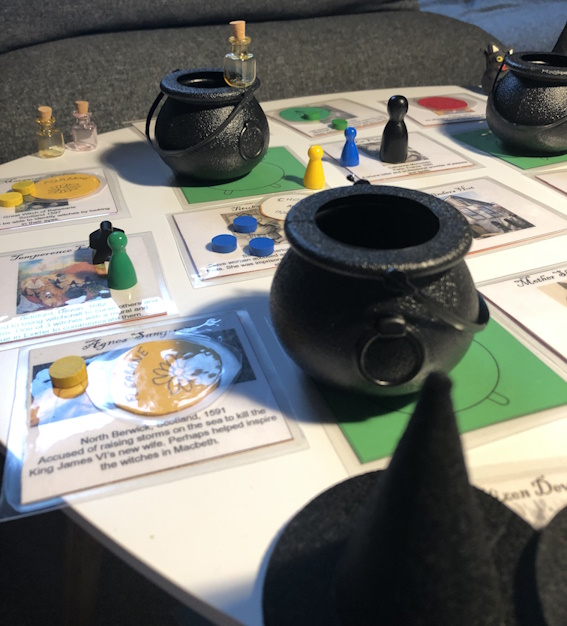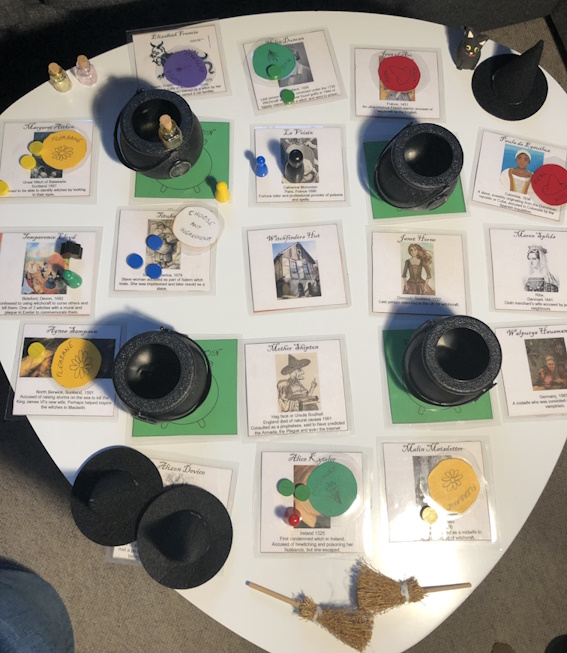by Ali Eriksen

You find yourself in a town made up of women, from many different countries and time periods, who were all accused of witchcraft. You will need to work together to meet the townswomen and find out if they will help you, or if they need your help. Can you find the coven of three witches and brew potions to protect them before the witchfinders arrest and test them?
Presentation
- Time: 60 min
- Players: 1 – 4
- Language: English
In ‘Which Witch is Which’ players move around a town of tiles representing real townswomen who have historically been accused of witchcraft. To win, players must find the coven of three witches and brew potions to protect them before the Witchfinders arrest and test them.
On each turn a player can take up to three actions. Conversations with their teammates about how to use these actions best are definitely encouraged!
Players can ‘Meet’ a Townswoman, revealing a random token hidden under the Townswoman tile. The token may supply a magical ingredient or it might reveal that the Townswoman is actually a ‘Real Witch’ and therefore in need of your help.
Players can also ‘Gather’ up magical ingredients; ‘Drop’ them into cauldrons placed around the board; ‘Send’ ingredients from one cauldron to another, ‘Rescue’ an arrested witch or ‘Collect’ a finished potion from a cauldron.
After a player’s three actions they must activate a Witchfinder. The roll of a dice determines whether the ‘Junior Witchfinder’ (who chases the nearest player) or the ‘Senior Witchfinder’ (who chases a found witch) is activated. How quickly Witchfinders move is determined by the Suspicion Level in the town. The Suspicion Level is increased by actions the players choose to do; such as finding a witch, brewing a potion or moving a witch. As Witchfinders move they confiscate magical ingredients in their path (stopping players from gaining essential ingredients to win the game) and hindering any magical activity from the tile they stand on.
In order to win the game players will need to create three invisibility potions in the cauldrons and place them on each of the three ‘Real Witches’.
Players lose the game if one ‘Real Witch’ is arrested by a Witchfinder and then tested.
They also lose if the suspicion level reaches the end of the Suspicion track, or if no more ingredients remain on the board.


About the designers

Ali is new to Fastaval and new to board game design. However, she has a lifetime fascination with all things ‘witchy’. So, when she was introduced to the concept of co-operative games by her boyfriend and fell in love, both with him and modern board games at the same time, she couldn’t help but enlist her twin children to play around with creating a witchy co-operative game together.
As Head of an International School in Denmark, and part of an amazing team of teachers, Ali believes life is a co-operative game which she is happily playing.

Kasper has played board games for more than 40 years. As a science librarian he loves to deconstruct games and scrutinize what makes a game bigger than the sum of its parts. He favors strategy games with historical settings. Kasper first Fastaval board game design “Witch Hunt” won an Otto for best board game and was published as “Pagan: Fate of Roanoke” in 2021.




